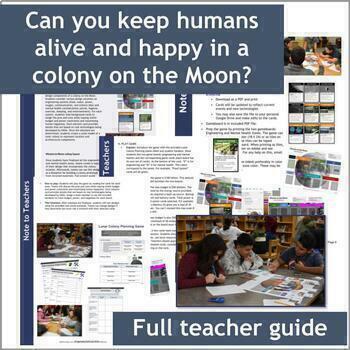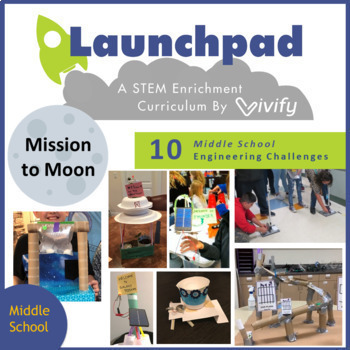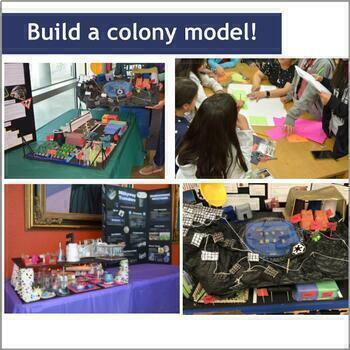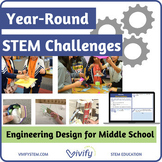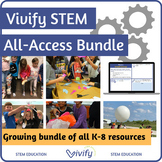Mission to Moon - Middle School Semester STEM Unit!
- Zip
What educators are saying
Products in this Bundle (5)
Also included in
- Space STEM Starter Challenges GROWING Bundle: Upper Elementary & Middle School STEMLaunch your students into STEM with these space-themed STEM challenges that incorporate the engineering design process. This mega bundle includes engaging STEM activities for space activities and design challengesPrice $226.72Original Price $283.40Save $56.68
- Are you in need of year-round STEM activities? This growing bundle includes our most popular STEM lessons and engineering design challenges for middle school grades! Click here for more guidance on planning out a STEM class including a scope and sequence and example STEM curriculum map. Includes a SPrice $388.52Original Price $485.65Save $97.13
- Are you in need of year-round STEM activities? This growing bundle includes ALL Vivify K-12 STEM lessons from team challenges, engineering design, semester-long STEM units, research projects, and more! Purchase everything for 20% off individual products! Here is a sample of what is included: Stage 1Price $990.24Original Price $1237.80Save $247.56
Description
Lesson Overview
Transform your classroom into a team of astronauts on a Mission to the Moon! This STEM curriculum begins with Stage 1 team challenges that build teamwork and communication skills. Mission Control then guides your class through Stage 2 engineering design challenges with each unit a progressively more complex design challenge as students arrive at and explore the Moon. The final phase is to tackle the Stage 3 Moon Colony project.
Units are aligned to science and math standards along with a different career focus. Each session has an instructional video led by an engineer, editable handouts, and a complete teacher's guide.
Part 1: Mission to Moon
STEM curriculum includes 10 engineering and teamwork challenges:
- Meet the Crew: Mission Patch
- Astronaut Training: Roller Coaster Engineering Challenge
- Astronaut Helmet: Astronaut Helmet Engineering Challenge
- Plants in Space: Plant Device Engineering Challenge
- Welcome Tower: Solar Power Engineering Challenge
- Moon Samples: Robotic Arm Engineering Challenge
- Rover Exploration: Rover Engineering Challenge
- Plus 3 Bonus Challenges!
- UV Shelter
- Rock Sample Collection
- STEM Careers BINGO
Part 2: Moon Colony Project
Students are now ready to tackle a research and design project that builds from the knowledge in part 1. Teams are tasked with designing a habitat on the Moon that to keep a crew of astronauts alive and happy. Students will need to consider questions like: How will colonists get food? What is the lunar environment like? Will our colony have a government? How do we prevent boredom? Students will apply scientific concepts, math skills, critical thinking, research, and engineering design to plan a long term habitat on the Moon. Click here to watch student project examples.
- Explore the Moon: Interactive games to learn about the Moon
- Moon Habitat Project Guide: A complete guide to support students through the engineering design process to think about, research, design, and build a colony on the Moon
- Mission to Moon Planning Game: Students plan out a Moon Habitat using game cards that include solutions for survival on the Moon. Each solution card provides details that are based on real technologies being developed by NASA. Students then create a 3D model of the habitat.
- Digital Moon Habitat Guide: A simplified version of the project is created with editable Google Slides to guide your students through all phases of the project: reflection, understanding of the Moon, research, designing, and building the lunar base.
Looking for more STEM lessons? Our team of engineers and educators is dedicated to developing low-prep and high-quality STEM activities for any classroom! Click below to learn more:
- Vivify's Scope & Sequence + Standards Alignment
- Vivify's Resource Guide
- Learn about the 3 Stages of STEM
- Vivify STEM Membership
Customer Tips:
• Click the Green ★ to follow our store and get notifications of new products and freebies
• Leave feedback to receive TpT credit for use on future purchases
• Questions? Contact us in the Product Q&A section
♥ Connect With Us ♥
Email us: info@vivifystem.com


